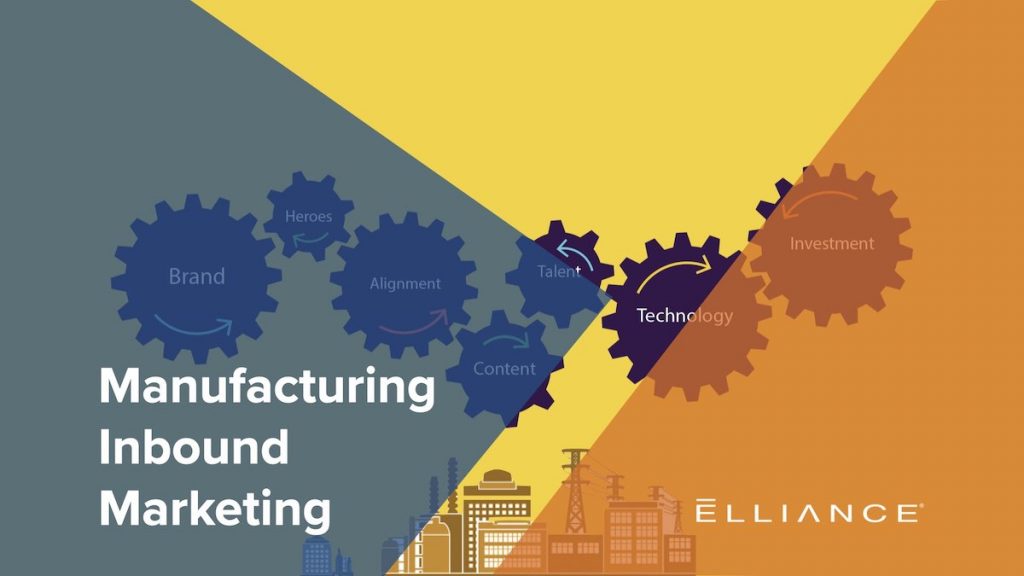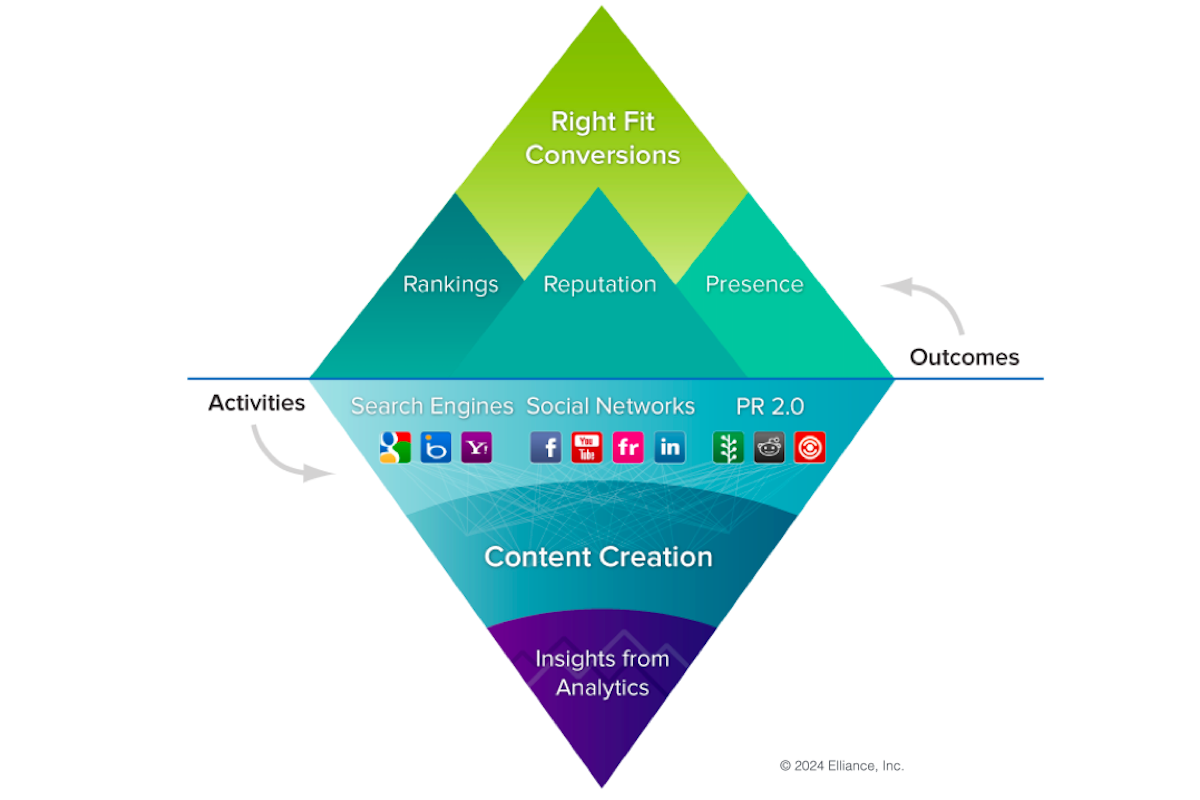| Aug 29, 2024
Manufacturing Inbound Marketing for Industrial Companies: Strategies, Tactics and Best Practices

Inbound marketing is the process of creating valuable content, attracting potential customers online, engaging prospects, and nurturing customer relationships through the buyer’s journey. Prospect relationships are proactively managed with CRM systems and marketing automation software. An advanced manufacturing client asked us to share our inbound marketing thinking with their team. This is what we shared with them.
What is Inbound Marketing
Traditional outbound marketing relies heavily on interrupting prospective customers with advertising, direct mail, etc. Inbound marketing takes a much different approach: earning attention and trust by providing valuable content and embracing personal interaction at various stages of the decision funnel. Inbound marketers help clients “get found” via search engines, word-of-mouth and the sharing of content. They engage prospects who already have an interest or inclination toward a particular offering, resulting in a pool of high quality leads who are more likely to convert. They opportunistically offer content that turns prospects into first-time customers and subsequently into repeat buyers.

Inbound marketing involves the continuous creation of relevant and high quality content, such as PR2.0 assets, articles, social posts, blog posts, videos, infographics, white papers and thought leadership events, and igniting that content through promotion and conversation-starters to encourage peer-to-peer sharing. Carefully curated content is distributed through channels you control (your “owned” media, such as your website and social networks) and the channels you don’t control (the social media of people/organizations in your network), where our content strategists spark conversations on your behalf. Carefully managing the content you own allows you to influence the content you “earn” and reputation you build. Search engine rankings and social connections (“likes,” “shares,” etc.) are among the most trusted endorsements online today. Managing your content and your interactions carefully allows you to maximize your success in SEO and the social world. Finally, advanced analytic approaches and marketing automation software allow you to improve your understanding of the content and communications your prospects value.
Inbound marketing creates a hub of value and trust. As this foundation is established, the cost to build upon it naturally drops. This means a very strong ROI over time for an inbound marketing focused approach.
Metaphorically speaking, an inbound marketing strategy is simply the act of gathering combustible firewood and igniting it.
Elements of a Productive Inbound Ecosystem
Conceptualizing a productive inbound ecosystem begins with a Keyword Guide. Use keyword research tools to create a company’s Keyword Guide with categories such as product lines, applications, industries served, geographies, reputation, and decision-making.
Next, develop a sophisticated Editorial Calendar and conceptualize what content must be created and how it should be distributed. Website, social media, e-newsletters form the underpinnings of a manufacturer inbound marketing distribution system. If a website is a manufacturer’s digital soul, then social media, e-newsletter and trade publications are its heart and brain. Successful inbound strategy rejuvenates these with content assets like:
- Persuasive stories
- Iconic photoshoots
- High-octane case studies that show customers as heroic problem solvers
- Webinars by subject matter experts
- Videos of product demonstrations
- Infographics
- Whitepapers
- Comparison sheets and Buyer’s Guides
- News & Events information revealing business vibrancy
- Blog posts that show products as solutions to customer’s problems in micro-niches in various industries
It’s crucial to have a conceptual picture of how your content fits into the buyer’s decision journey. Here is our model for mapping content on that journey.

Finally, use a CRM system and marketing automation software to connect the dots between content, buyer’s journey and conversions. Create a demand generation model to formulate predictions for future growth.
Inbound Marketing & Paid Advertising: Good Alone, Better Together.
With inbound marketing, it takes a few months to achieve local, regional and national Google page one rankings, and often a year or more to achieve international rankings.
Elliance, a believer in the power of AND-thinking and not EITHER-OR-thinking, recommends that marketers embrace both inbound marketing and paid advertising. In fact, we see a mutually reinforcing relationship between them i.e. they are good alone, but better together.
While paid marketing gives a short-term boost, inbound marketing creates an enduring, rising tide of Google page one rankings. Patient inbound marketers are able to reduce their paid marketing spend over time as SEO rankings are achieved.
Research has shown that if a website surfaces on both organic and paid listings on Google page one, click-through rates and conversion rates increase by 4.5 fold.
The bottom line is that inbound marketing and paid advertising are mutually reinforcing.

Inbound, Paid and Website play Unique Roles in the Customer Life Cycle
To attract customers, inbound marketing and paid advertising play the role of a demand engine. If your company can’t be found, you can’t be bought.
To convert a prospect into a customer, a website plays the role of a conversion machine. If a website fails to persuade a prospect to buy your product, your company will not thrive and prosper.
To retain customers, quality of your product and service calls are moments of truth. Inbound marketing also reduces buyer’s remorse and reassures customers they made the right decision in choosing you.
Superior products and experiences cement recurring revenue streams, enduring relationships and new opportunities for cross-selling and up-selling.
Best Practices for Manufacturing Inbound Marketing
- Begin by asking “what do you want more of?” When Alice asks the Cheshire Cat for direction in Alice in Wonderland, the cat responds “If you don’t know where you’re going, any road will get you there.” Before you begin the journey, know what mountains are yours to claim. Are you striving to fortify your brand reputation, attracting and retaining talent, improving your capacity utilization, reducing your sales cycle, securing new customers, cross-selling to existing customers, opening new markets, attracting strategic buyers, or persuading tactical buyers.
- Formulate a Keyword Guide. Use keyword research tools to create a Keyword Guide. Categories include products, applications, industries, locations, reputation and decisioning.
- Never create a piece of new content without knowing the keyword first. Start with a keyword. Produce new content to achieve Google page one rankings. Ensure that keywords are baked into the code and content. This is true for new blog posts, podcasts, webinars, white papers, infographics, videos, and events.
- Realize that your website is a store with a thousand doors. Fortify each entry point. Merchandise smartly. Buyers don’t enter from the front entrance, or homepage, only. If you optimize the entire website correctly mapping the keywords to the right website pages, prospects will enter from many pages of your website. Strengthen each page. Cross-sell related products and services.
- Quench buyer’s thirst, but don’t satiate. When buyers are looking for information, give them enough to invite a call, but not so much that they make up their mind. Sales are still made on trust and emotional factors, not just rational facts. So, create pages that are long enough but not longer than necessary.
- Embrace a broader definition of search. Once upon a time, SEO happened on Google, Bing and Yahoo only. It now also happens on new hangouts like YouTube, Flickr, Facebook, Instagram, Twitter, LinkedIn, Quora, and Reddit. Scrutinize them and optimize all touch points.
- Use SEO best practices. Implement on-page factors. Make your website responsive, secure and fast. Build quality inbound links. Manage social signals. Optimize for locations and geographies. Create fresh content. God is in the details.
- Run mutually enhancing SEO, social media, PR2.0 and paid advertising campaigns. They are good alone, better together. Once distinct, they are now mutually reinforcing and give search ranking lifts. Orchestrate them wisely and smartly.
- Manage people, process and technology: Get the best talent to manage the key components of a content ecosystem including Keyword Guide, Writing Style Guide, Content Governance Guide, marketing automation software, CRM system and analytic tools. These must be managed proactively, rationally and systematically. They must cultivate the habits of quality, content, rankings, data and predictable performance.
- Be data driven. What you can’t measure, you can’t manage. Effective inbound marketing strategy mandates you measure the ROI of your efforts via dashboards and KPIs. Go beyond the basic measures like traffic, likes, etc. Work backwards from the goals like inquiries, calls, opportunities, sales, etc. Measure upstream metrics like content popularity, page one keyword rankings, branded vs. non-branded search volume, number of shares, and bounce rate. Ultimately it’s all about conversion ratios and shape of the conversion funnel across the buyer’s journey.
If you are seeking a talented manufacturing marketing agency with content marketing expertise, consider partnering with us.
